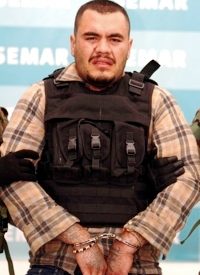
The April 24 Washington Post reported an update of the findings of Mexican mass graves, revealing a shocking level of butchery employed by the killers. The body count has climbed to 177 (and is expected to rise) recovered from graves found near ranches close to San Fernando in Mexico’s northern state of Tamaulipas. Most of the civilian victims were abducted from passenger busses, and authorities say that few bullet casings and little evidence have been recovered that would indicate the victims died from gunshot wounds. The cause of death for most was blunt force trauma to the head.
Almost all bodies had been stripped of identification, making progress more difficult, and most, though badly decomposed, bore signs of severe cranial trauma. A sledgehammer found at the scene could have been the instrument used in the killings. A number of pits were used to bury the bodies; the largest two, dug by a backhoe, contained 43 and 45 bodies, respectively.
Authorities are still only speculating about possible reasons for the killings. Victims’ families were not contacted with ransom demands, and it doesn’t appear that the bus passengers traveled with large amounts of cash. The best motive posited so far is that drug cartel members, assumed to be the killers, were attempting to force recruits to join their numbers.
Officials report that they’ve found 34 gravesites near San Fernando. “Perhaps we are seeing in the graves the results of several different confrontations and crimes committed over many months,” said Morelos Canseco Gomez, the Lieutenant Governor of Tamaulipas. He also stated that a search is still being conducted for an entire bus that vanished on the border in March. The town lies about 90 miles south of the international border on a major route leading north into Texas, and the area was also the site of a massacre last year of 72 migrants, mostly Central Americans, trying to reach the U.S. Last week, Mexican marines established a military camp for patrols and forensic crews in the region.
After last August’s massacre, Mexican President Felipe Calderon sent military forces to retake San Fernando, but according the Washington Post, “…as attention on San Fernando faded, federal forces withdrew and locals say the crime gangs quickly muscled their way back in.”
“People began to disappear,” recounted Ramón Ruiz, an apprentice priest in San Fernando. “First it was people with money, then it was anyone. They kidnapped a local farmer’s son and demanded $10,000, and when he gave them $5,000 — everything he had — they sent him half of his son.” Criminals commandeered ranches, killed the owners, and converted buildings into holding pens and execution chambers. The town remained silenced until March, when officials received reports of the bus abductions. Acting on a tip, soldiers went to a remote ranch, later freeing five victims and capturing Zeta drug cartel members. The resulting investigation revealed the existence of the graves.
Authorities also arrested 17 San Fernando police officers, suspecting they had provided cover for the Zetas and their killing sprees, and on Thursday also arrested the police chief. The town is now effectively under martial law, with marines patrolling the streets. Local authorities will not go to surrounding villages without a military escort.
Early Thursday morning, in the Tamaulipas town called Miguel Aleman, across the border from Roma, Texas, local Zetas went on a shooting rampage of vandalizing, burning, and looting. The headquarters of the Tamaulipas State Police, and nearly a dozen other buildings, were torched, killing one civilian and several gunmen. After opening fire on a military patrol in Reynosa, the Zetas moved to Miguel Aleman, where they attacked the police building and terrorized the rest of the town. They set fire to car dealerships, an auto parts business, a convenience store, and other establishments before police were eventually able to contain the situation.
The level of terror has now been elevated in border towns, and disapproval of Calderon and his policies is growing. Many blame the President’s declaration of war against the drug cartels for the more than 36,000 murders since he took office four years ago.
However, the nation’s police and other officials are known for corruption. Incredibly, in an interview, San Fernando Mayor Tomas Gloria Requena claimed it wasn’t true that his town was especially corrupt or evil: “San Fernando is Mexico. It’s just like anywhere else,” he insisted. But last year in nearby Monterrey, the town’s mayor, Edelmiro Cavazos, was abducted from his home and killed. Local police were later arrested in connection with his murder, and the scenario has been repeated throughout the country.
As of the weekend, authorities had arrested 76 suspects for the San Fernando killings, including alleged Zeta boss Martin “El Kilo” Estrada Luna (above), who is believed to have been the mastermind of the bus killings, and who grew up north of the border in Washington State.
Photo: Martin Omar Estrada Luna, alias "El Kilo," looks on during his presentation to the press in Mexico City, April 17, 2011: AP Images


